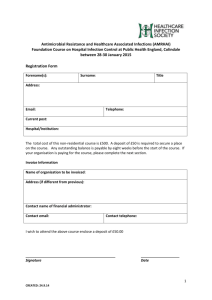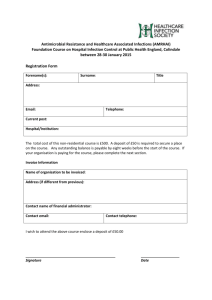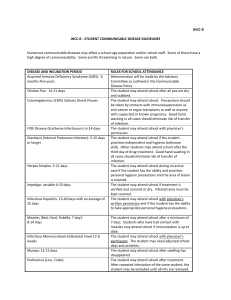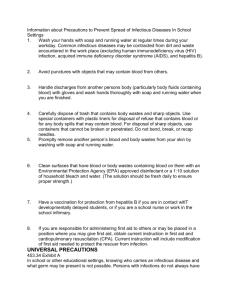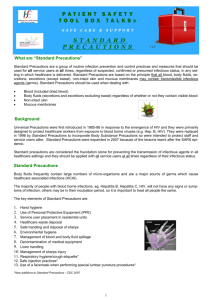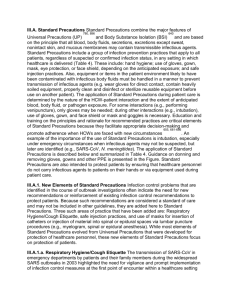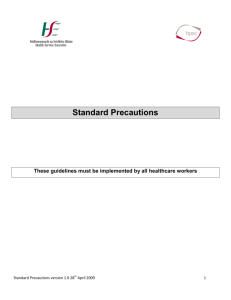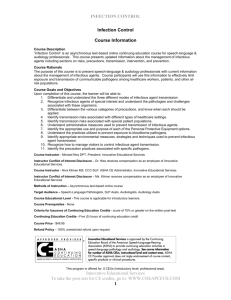Cluster Area of Compet ency Competency Statement Terminal
advertisement
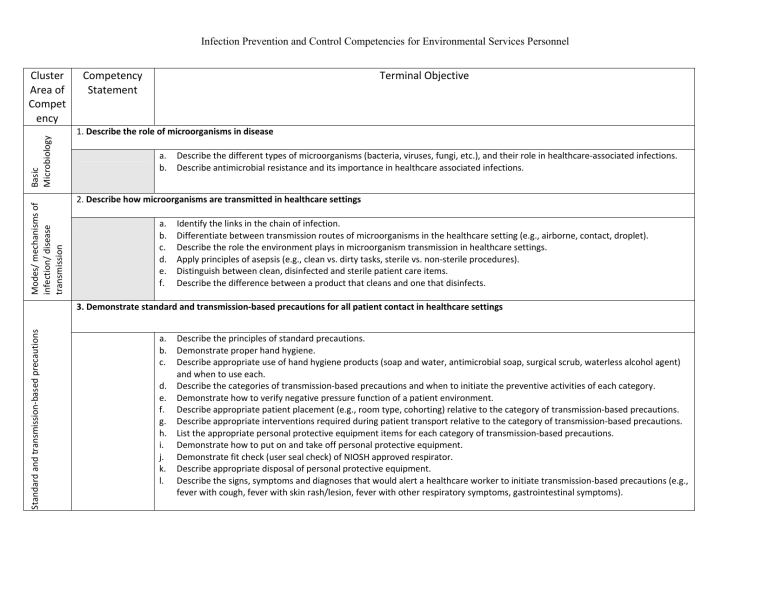
Infection Prevention and Control Competencies for Environmental Services Personnel Modes/ mechanisms of infection/ disease transmission Basic Microbiology Cluster Area of Compet ency Competency Statement Terminal Objective 1. Describe the role of microorganisms in disease a. b. Describe the different types of microorganisms (bacteria, viruses, fungi, etc.), and their role in healthcare‐associated infections. Describe antimicrobial resistance and its importance in healthcare associated infections. 2. Describe how microorganisms are transmitted in healthcare settings a. b. c. d. e. f. Identify the links in the chain of infection. Differentiate between transmission routes of microorganisms in the healthcare setting (e.g., airborne, contact, droplet). Describe the role the environment plays in microorganism transmission in healthcare settings. Apply principles of asepsis (e.g., clean vs. dirty tasks, sterile vs. non‐sterile procedures). Distinguish between clean, disinfected and sterile patient care items. Describe the difference between a product that cleans and one that disinfects. Standard and transmission‐based precautions 3. Demonstrate standard and transmission‐based precautions for all patient contact in healthcare settings a. b. c. d. e. f. g. h. i. j. k. l. Describe the principles of standard precautions. Demonstrate proper hand hygiene. Describe appropriate use of hand hygiene products (soap and water, antimicrobial soap, surgical scrub, waterless alcohol agent) and when to use each. Describe the categories of transmission‐based precautions and when to initiate the preventive activities of each category. Demonstrate how to verify negative pressure function of a patient environment. Describe appropriate patient placement (e.g., room type, cohorting) relative to the category of transmission‐based precautions. Describe appropriate interventions required during patient transport relative to the category of transmission‐based precautions. List the appropriate personal protective equipment items for each category of transmission‐based precautions. Demonstrate how to put on and take off personal protective equipment. Demonstrate fit check (user seal check) of NIOSH approved respirator. Describe appropriate disposal of personal protective equipment. Describe the signs, symptoms and diagnoses that would alert a healthcare worker to initiate transmission‐based precautions (e.g., fever with cough, fever with skin rash/lesion, fever with other respiratory symptoms, gastrointestinal symptoms). Occupational Health 4. Describe occupational health practices that protect the healthcare worker from acquiring infection a. b. c. d. e. f. g. Demonstrate safe handling and disposal of sharps. Demonstrate appropriate use of safety devices. Explain methods to safely handle blood and body fluids to prevent exposure. Describe the first aid for cut/puncture exposures, or fluid exposures to the eyes, nose or mouth. Articulate the process for reporting blood/body fluid exposure in the workplace. Describe appropriate disposal of items soaked/saturated with blood/body fluids or other potentially infectious materials. Describe regulated waste versus general trash and the appropriate disposal of each Patient Safety 5. Describe occupational health practices that prevent the healthcare worker from transmitting infection to a patient a. b. c. d. Describe work practices that reduce the risk of infection transmission (e.g., immunization, not coming to work sick, hand hygiene). Explain the importance of healthcare worker participation in immunization programs. Describe how a staff member with an infectious condition can pose a risk to other healthcare worker, patients, and visitors Describe signs, symptoms and diagnoses that require absence from work or work restrictions (e.g., fever with cough, fever with skin rash/lesion, fever with other respiratory symptoms, gastrointestinal symptoms). Critical Thinking 6. Demonstrate ability to problem‐solve and apply knowledge to recognize, contain, and prevent infection transmission a. b. c. Explain how to access infection control resources including policies and procedures. Discuss own role in infection prevention and control (e.g., recognizing unsafe activities, intervening when breaches in infection control are identified). Describe practice changes (e.g., altered standard of care) in the event of limited resources. Emergency Preparedness 7. Describe the importance of healthcare preparedness for natural or man‐made infectious disease disasters. a. b. c. Explain own role in the facility disaster plan. Demonstrate participation in facility drills and exercises. Describe practice changes (e.g., altered standard of care) in the event of limited resources 07/11 Ruth.carrico@louisville.edu
